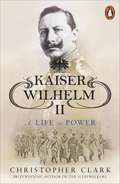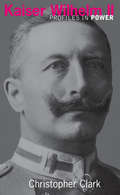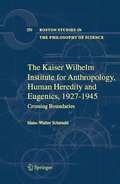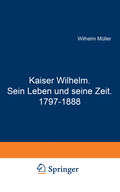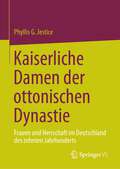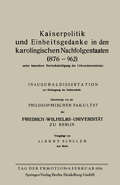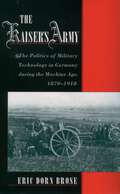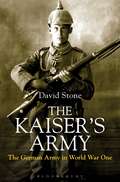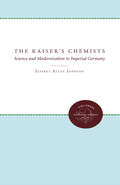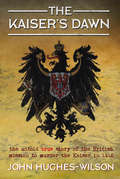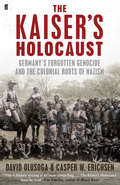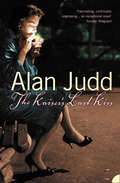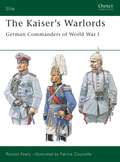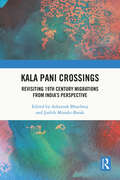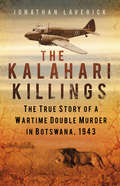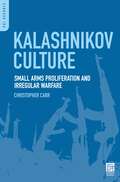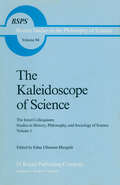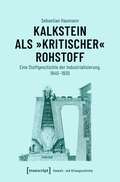- Table View
- List View
Kaiser Wilhelm II: A Life in Power
by Christopher ClarkKing of Prussia, German Emperor, war leader and defeated exile, Kaiser Wilhelm II was one of the most important - and most controversial - figures in the history of twentieth-century Europe. But how much power did he really have?The acclaimed historian Christopher Clark follows Kaiser Wilhelm's political career from his youth at the Hohenzollern court through the turbulent decades of the Wilhelmine era into global war and the collapse of Germany in 1918, to his last days. He asks: what was his true role in the events that led to the outbreak of the First World War? What was the nature and extent of his control? What were his political goals and his success in achieving them? How did he project authority and exercise influence? How did the people view him?Through original research, Clark presents a fresh new interpretation of this contentious figure, focusing on how his forty-year reign from 1888 to 1918 affected Germany, and the rest of Europe, for years to come.
Kaiser Wilhelm II
by Christopher St ClarkKaiser Wilhelm II is one of the key figures in the history of twentieth-century Europe: King of Prussia and German Emperor from 1888 to the collapse of Germany in 1918 and a crucial player in the events that led to the outbreak of World War I. Following Kaiser Wilhelm's political career from his youth at the Hohenzollern court through the turbulent peacetime decades of the Wilhelmine era into global war and exile, the book presents a new interpretation of this controversial monarch and assesses the impact on Germany of his forty-year reign.
Kaiser Wilhelm II
by Christopher St ClarkKaiser Wilhelm II is one of the key figures in the history of twentieth-century Europe: King of Prussia and German Emperor from 1888 to the collapse of Germany in 1918 and a crucial player in the events that led to the outbreak of World War I. Following Kaiser Wilhelm's political career from his youth at the Hohenzollern court through the turbulent peacetime decades of the Wilhelmine era into global war and exile, the book presents a new interpretation of this controversial monarch and assesses the impact on Germany of his forty-year reign.
The Kaiser Wilhelm Institute for Anthropology, Human Heredity and Eugenics, 1927-1945: Crossing Boundaries (Boston Studies in the Philosophy and History of Science #259)
by Hans-Walter SchmuhlWhen the Kaiser Wilhelm Institute for Anthropology, Human Heredity and Eugenics opened its doors in 1927, it could rely on wide political approval. In 1933 the institute and its founding director Eugen Fischer came under pressure to adjust, which they were able to ward off through Selbstgleichschaltung (auto-coordination). The Third Reich brought about a mutual beneficial servicing of science and politics. With their research into hereditary health and racial policies the institute’s employees provided the Brownshirt rulers with legitimating grounds. This volume traces the history of the Kaiser Wilhelm Institute for Anthropology, Human Heredity and Eugenics between democracy and dictatorship. Attention is turned to the haunting transformation of the research program, the institute’s integration into the national and international science panorama, and its relationship to the ruling power. The volume also confronts the institute’s interconnection to the political crimes of Nazi Germany terminating in bestial medical crimes.
Kaiserliche Damen der ottonischen Dynastie: Frauen und Herrschaft im Deutschland des zehnten Jahrhunderts
by Phyllis G. JesticeIm Europa des zehnten Jahrhunderts und insbesondere in Deutschland konnten kaiserliche Frauen in einer Weise Macht ausüben, wie es in früheren Jahrhunderten kaum vorstellbar war. Theophanu und Adelheid waren zwei der einflussreichsten Persönlichkeiten im ottonischen Reich, zusammen mit ihren Ehemännern, die sich stark auf ihre Unterstützung verließen. Phyllis G. Jestice untersucht eine Reihe von Faktoren, die zu ihrer Macht und ihrem Prestige beitrugen, darunter die gesellschaftliche Einstellung gegenüber Frauen, ihr Reichtum, ihre Salbung als Königin und ihr sorgfältig aufgebautes Image der Frömmigkeit. Aufgrund ihrer einflussreichen Stellung konnten Theophanu und Adelheid die Herrschaft über den jungen Otto III. trotz des erbitterten Widerstands Heinrichs des Zänkers während des Thronstreits von 984 zurückgewinnen. Indem es untersucht, wie sie die Regentschaft erfolgreich sicherten, konfrontiert dieses Buch die überholte Vorstellung des Exzeptionalismus und beleuchtet das Leben der mächtigen ottonischen Frauen.
Kaiserpolitik und Einheitsgedanke in den karolingischen Nachfolgestaaten (876–962) unter besonderer Berücksichtigung des Urkundenmaterials
by Albert SchulzeDieser Buchtitel ist Teil des Digitalisierungsprojekts Springer Book Archives mit Publikationen, die seit den Anfängen des Verlags von 1842 erschienen sind. Der Verlag stellt mit diesem Archiv Quellen für die historische wie auch die disziplingeschichtliche Forschung zur Verfügung, die jeweils im historischen Kontext betrachtet werden müssen. Dieser Titel erschien in der Zeit vor 1945 und wird daher in seiner zeittypischen politisch-ideologischen Ausrichtung vom Verlag nicht beworben.
The Kaiser's Army: The Politics of Military Technology in Germany during the Machine Age, 1870-1918
by Eric Dorn BroseThis volume covers a fascinating period in the history of the German army, a time in which machine guns, airplanes, and weapons of mass destruction were first developed and used. Eric Brose traces the industrial development of machinery and its application to infantry, cavalry, and artillery tactics. He examines the modernity versus anti-modernity debate that raged after the Franco-Prussian war, arguing that the residue of years of resistance to technological change seriously undermined the German army during World War I.
The Kaiser's Army: The Politics of Military Technology in Germany during the Machine Age, 1870-1918
by Eric Dorn BroseThis volume covers a fascinating period in the history of the German army, a time in which machine guns, airplanes, and weapons of mass destruction were first developed and used. Eric Brose traces the industrial development of machinery and its application to infantry, cavalry, and artillery tactics. He examines the modernity versus anti-modernity debate that raged after the Franco-Prussian war, arguing that the residue of years of resistance to technological change seriously undermined the German army during World War I.
The Kaiser's Army: The German Army in World War One
by David StoneIn this comprehensive book, David Stone describes and analyses every aspect of the German Army as it existed under Kaiser Wilhelm II, encompassing its development and antecedents, organisation, personnel, weapons and equipment, its inherent strengths and weaknesses, and its victories and defeats as it fought on many fronts throughout World War I.The book deals in considerable detail with the origins and creation of the German army, examining the structure of power in German politics and wider society, and the nation's imperial ambitions, along with the ways in which the high command and general staff functioned in terms of strategy and tactical doctrine. The nature, background, recruitment, training and military experiences of the officers, NCOs and soldiers are examined, while personal and collective values relating to honour, loyalty and conscience are also analysed. There is also an evaluation of all aspects of army life such as conscription, discipline, rest and recuperation and medical treatment. In addition the army's operations are set in context with an overview of the army at war, covering the key actions and outcomes of major campaigns from 1914 to 1918 up to the signature of the Armistice at Compiègne. For anyone seeking a definitive reference on the German Army of the period – whether scholar, historian, serving soldier or simply a general reader – this remarkable book will prove an invaluable work.
The Kaiser's Army: The German Army in World War One
by David StoneIn this comprehensive book, David Stone describes and analyses every aspect of the German Army as it existed under Kaiser Wilhelm II, encompassing its development and antecedents, organisation, personnel, weapons and equipment, its inherent strengths and weaknesses, and its victories and defeats as it fought on many fronts throughout World War I.The book deals in considerable detail with the origins and creation of the German army, examining the structure of power in German politics and wider society, and the nation's imperial ambitions, along with the ways in which the high command and general staff functioned in terms of strategy and tactical doctrine. The nature, background, recruitment, training and military experiences of the officers, NCOs and soldiers are examined, while personal and collective values relating to honour, loyalty and conscience are also analysed. There is also an evaluation of all aspects of army life such as conscription, discipline, rest and recuperation and medical treatment. In addition the army's operations are set in context with an overview of the army at war, covering the key actions and outcomes of major campaigns from 1914 to 1918 up to the signature of the Armistice at Compiègne. For anyone seeking a definitive reference on the German Army of the period – whether scholar, historian, serving soldier or simply a general reader – this remarkable book will prove an invaluable work.
The Kaiser's Chemists: Science and Modernization in Imperial Germany
by Jeffrey Allan JohnsonIn the early twentieth century, an elite group of modern-minded scientists in Germany, led by the eminent organic chemist Emil Fischer, set out to create new centers and open new sources of funding for chemical research. Their efforts led to the establishment in 1911 of the chemical institues of the Kaiser Wilhelm Society for the Advancement of the Sciences, whose original staff included several future Nobel laureates. Although these institutes were designed to promote "free research" that would uphold German Leadership in international science, they also came to promote the integration of science in the German war effort after 1914. According to Jeffrey Johnson, the development of the Kaiser Wilhelm Institutes exemplifies the origins and dilemmas of one of the most significant innovations in modern science: the creation of institutions for basic research, both theoretical and practical.The Kaiser Wilhelm Society was a quasi-official institution under the "protection" of Kaiser Wilhelm II, but it received most of its funding from German industry rather than the Imperial Treasury. After 1914, however, the Kaiser's chemists and their institutes provided key support to the German war effort. Within a few months of the outbreak of World War I, the institutes had been integrated into war mobilization activities. They conducted research both in weapons, such as poison gas, and in strategic resources, especially synthetics to replace naturally produced goods cut off by Britain's blockade of German ports.By examining the Kaiser Wilhelm Society in the framework of both scientific and social change, Johnson is able to answer questions that seem puzzling if not viewed from this dual perspective, such as why German chemists pushed for institutional change at this particular time. Johnson argues that the new institutes arose from a characteristically modern tension between internationally set scientific goals and the competing national priorities of a country headed for war. Johnson's sources include the papers of Emil Fischer; the archives of several major German corporations, including Bayer, Hoechst, and Krupp; government records; and the archives of the Max Planck Society, which grew out of the Kaiser Wilhelm Society after World War II.Originally published in 1990.A UNC Press Enduring Edition -- UNC Press Enduring Editions use the latest in digital technology to make available again books from our distinguished backlist that were previously out of print. These editions are published unaltered from the original, and are presented in affordable paperback formats, bringing readers both historical and cultural value.
The Kaiser's Dawn: The Untold Story of Britain’s Secret Mission to Murder the Kaiser in 1918
by John Hughes-WilsonIn mid summer 1918 a top secret mission, which has remained classified information for a century, was set in motion to kill Kaiser Wilhelm II. It was felt that by killing their head of state and commander in chief it would serve as a mortal blow to the German forces and they would collapse very quickly after the assassination. The facts are borne out in never-before-published notebooks, maps and pilots’ flying records, kept secret for a hundred years. The implications of this secret attack raise many new – and explosive - questions. Exactly who ordered an attack to kill the Kaiser? Was it sanctioned by the C-in-C, Sir Douglas Haig? By the War Office? Was the King informed of the attempt to kill his royal cousin? Was Lloyd George, the Prime Minister asked? We do not know; but someone in London must have sanctioned the attack. The Official History makes no mention of any attack, and public records say nothing. John Hughes-Wilson has woven an exciting and well-paced historical novel to mark this centennial event from the research on discovering this mission. The story, based on true events, looks at this long hidden secret and puts it into the context of the time. It explores areas rarely examined: secret service operations in 1914-18; dirty, undercover intelligence work; the very real political intrigues between Whitehall and the generals and the heroics of the aircrew of the day, whose life expectancy at one point in 1917 was only eleven days in action.
The Kaiser's Holocaust: Germany's Forgotten Genocide and the Colonial Roots of Nazism
by Casper Erichsen David OlusogaOn 12 May 1883, the German flag was raised on the coast of South-West Africa, modern Namibia - the beginnings of Germany's African Empire. As colonial forces moved in , their ruthless punitive raids became an open war of extermination. Thousands of the indigenous people were killed or driven out into the desert to die. By 1905, the survivors were interned in concentration camps, and systematically starved and worked to death.Years later, the people and ideas that drove the ethnic cleansing of German South West Africa would influence the formation of the Nazi party. The Kaiser's Holocaust uncovers extraordinary links between the two regimes: their ideologies, personnel, even symbols and uniform. The Herero and Nama genocide was deliberately concealed for almost a century. Today, as the graves of the victims are uncovered, its re-emergence challenges the belief that Nazism was an aberration in European history. The Kaiser's Holocaust passionately narrates this harrowing story and explores one of the defining episodes of the twentieth century from a new angle. Moving, powerful and unforgettable, it is a story that needs to be told.
The Kaiser’s Last Kiss
by Alan JuddA fictionalised account of the Kaiser Wilhelm’s last years in Nazi-occupied Holland.
The Kaiser's Warlords: German Commanders of World War I (Elite #97)
by Patrice Courcelle Ronald PawlyThe turn of the 20th century saw Imperial Germany as essentially a militarist state, whose growing industrial resources and wealth were harnessed to the task of increasing German military power, at a time of aggressive expansionist diplomacy in competition with Britain and France. After her victories over Austria in the 1860s and France in 1870, Germany's General Staff enjoyed tremendous professional prestige throughout Europe, and was the model for all aspects of command and control. The German army was essentially that of Prussia, Bavaria and Saxony with smaller contingents from the lesser states. Its generals were the men who planned, initiated, and to a large extent controlled the course of World War I.
Kala Pani Crossings: Revisiting 19th Century Migrations from India’s Perspective
by Ashutosh Bhardwaj Judith Misrahi-BarakWhen used in India, the term Kala pani refers to the cellular jail in Port Blair, where the British colonisers sent a select category of freedom fighters. In the diaspora it refers to the transoceanic migration of indentured labour from India to plantation colonies across the globe from the mid-19th century onwards. This volume discusses the legacies of indenture in the Caribbean, Reunion, Mauritius, and Fiji, and how they still imbue our present. More importantly, it draws attention to India and raises new questions: doesn’t one need, at some stage, to wonder why this forgotten chapter of Indian history needs to be retrieved? How is it that this history is better known outside India than in India itself? What are the advantages of shining a torch onto a history that was made invisible? Why have the tribulations of the old diaspora been swept under the carpet at a time when the successes of the new diaspora have been foregrounded? What do we stand to gain from resurrecting these histories in the early 21st century and from shifting our perspectives? A key volume on Indian diaspora, modern history, indentured labour, and the legacy of indentureship, this co-edited collection of essays examines these questions largely through the frame of important works of literature and cinema, folk songs, and oral tales, making it an artistic enquiry of the past and of the present. It will be of great interest to scholars and researchers of world history, especially labour history, literature, postcolonial studies, cultural studies, diaspora studies, sociology and social anthropology, Indian Ocean studies, and South Asian studies.
Kala Pani Crossings: Revisiting 19th Century Migrations from India’s Perspective
by Ashutosh Bhardwaj Judith Misrahi-BarakWhen used in India, the term Kala pani refers to the cellular jail in Port Blair, where the British colonisers sent a select category of freedom fighters. In the diaspora it refers to the transoceanic migration of indentured labour from India to plantation colonies across the globe from the mid-19th century onwards. This volume discusses the legacies of indenture in the Caribbean, Reunion, Mauritius, and Fiji, and how they still imbue our present. More importantly, it draws attention to India and raises new questions: doesn’t one need, at some stage, to wonder why this forgotten chapter of Indian history needs to be retrieved? How is it that this history is better known outside India than in India itself? What are the advantages of shining a torch onto a history that was made invisible? Why have the tribulations of the old diaspora been swept under the carpet at a time when the successes of the new diaspora have been foregrounded? What do we stand to gain from resurrecting these histories in the early 21st century and from shifting our perspectives? A key volume on Indian diaspora, modern history, indentured labour, and the legacy of indentureship, this co-edited collection of essays examines these questions largely through the frame of important works of literature and cinema, folk songs, and oral tales, making it an artistic enquiry of the past and of the present. It will be of great interest to scholars and researchers of world history, especially labour history, literature, postcolonial studies, cultural studies, diaspora studies, sociology and social anthropology, Indian Ocean studies, and South Asian studies.
The Kalahari Killings: The True Story of a Wartime Double Murder in Botswana, 1943
by Jonathan LaverickOn 4 October 1943 two RAF pupil pilots, Walter Adamson and Gerald Edwards, took off from Kumalo (Zimbabwe). Some time later they were forced to land in Botswana. They climbed out unscathed, left a note, and disappeared. What happened next would entail ethno-archaelogical investigation, a sensational murder trial with worldwide media coverage – and a sensational outcome – that led to a profound change in the lives of the Tyua Bush people. The airmen had been murdered by bullet and axe – but why? The leader of the group of eight killers charged, Twai Twai Molele, was known to be a witchdoctor and a bottle allegedly containing human fat was found in his possession… Following the trial the Tyuas’ guns were confiscated and their ageless nomadic hunting life began to die out. The murders offered an excuse for British-protected ranchers to take their lands. Reopening this extraordinary case, Jonathan Laverick reviews the evidence to uncover the true story.
Kalashnikov Culture: Small Arms Proliferation and Irregular Warfare (PSI Reports)
by Christopher CarrThis work is a bridge between the failed/weak states' literature and that which examines issues relating to small arms proliferation. Carr investigates the cultural impact of the availability of these easy-to-come-by weapons. This cultural dynamic has a direct, and deadly impact on issues such as arms control, illegal and illicit trading, gun cultures, the nexus between criminality and militia warfare and the social impact of arms proliferation, and the struggle for weak states who attempt to govern. The case studies will appeal to those with regional or comparative interests. Although the tone is academic, the topics and the subject matter will make this book of interest to those outside of the academic community.The work takes the form of alternating chapters in which elements of Kalashnikov enculturation, for example the peculiar forms of aberrant economic activity that exist within Kalashnikov cultures, are paired with chapter-length mini-case studies, such as that dealing with armed gang movements in Jamaica, Papua New Guinea, and Brazil. The whole work is bounded by the contention that under certain conditions heavily weaponized societies create their own milieu, which in turn gives rise to communities that find ways to survive (and sometimes thrive) within an ambiance of chronic insecurity.
The Kaleidoscope of Science: The Israel Colloquium: Studies in History, Philosophy, and Sociology of Science Volume 1 (Boston Studies in the Philosophy and History of Science #94)
by EdnaUllmann-MargalitThis collection is the first proceedings volume of the lectures delivered within the framework of the Israel Colloquium for the History, Philosophy and Sociology of Science, in its year of inauguration 1981-82. It thus marks the beginning of a new venture. Rather than attempting to express an ideology of the l}nity of science, this collection in fact aims at presenting a kaleidoscopic picture of the variety of views about science and within science. Three main disciplines come together in this volume. The first of scientists, the second of historians and sociologists of science, the third of philosophers interested in science. The scientists try to present the scientific body of knowledge in areas where the scientific adventure kindles the imagination of the culture of our time. At the same of course, they register their own reflections on the nature of this body time, of knowledge and on its likely course of future development. For the historians and sociologists, in contrast, science is there to be studied diachronically, as a process, on the one hand, and synchronically, as a social institution, on the other. As for the phil9sophers, finally, their contribution to this series is not meant to remain within the confines of what is usually seen as the philosophy of science proper, or to be limited to the analysis of the scientific mode of reasoning and thinking: it is allowed, indeed encouraged, to encompass alter native, and on occasion even competing, modes of thought.
Kalkiyin Sivakamiyin Sabadham Part I Tremor (Chapters 1-47)
by Kalki KrishnamurthyA historical four parts novel set in 7th Century in South India against the backdrop of various historical events and figures revolving around the Chalukya King, Pulikesi II laying a siege of Kanchi and Narasimhavarman avenging this by attacking Vatapi, the capital of the Chalukyas. Sivakami a dancer close to the heart of Pallava King Narasimhavaraman, vows that she would not leave Vatapi until Narasimhavarman burns it down and rescues her. Finally, Sivagami is united with her aging father. She is initially heart-broken on realising that Narasimhavarman is married to someone else, but later decides to dedicate herself to the God Shiva.
Kalkiyin Sivakamiyin Sabadham Part III Love of Monk (Chapters 1-57)
by Kalki KrishnamurthyA historical four parts novel set in 7th Century in South India against the backdrop of various historical events and figures revolving around the Chalukya King, Pulikesi II laying a siege of Kanchi and Narasimhavarman avenging this by attacking Vatapi, the capital of the Chalukyas. Sivakami a dancer close to the heart of Pallava King Narasimhavaraman, vows that she would not leave Vatapi until Narasimhavarman burns it down and rescues her. Finally, Sivagami is united with her aging father. She is initially heart-broken on realising that Narasimhavarman is married to someone else, but later decides to dedicate herself to the God Shiva.
Kalkiyin Sivakamiyin Sabadham Part IV Shattered Dream (Chapters 1-50)
by Kalki KrishnamurthyA historical four parts novel set in 7th Century in South India against the backdrop of various historical events and figures revolving around the Chalukya King, Pulikesi II laying a siege of Kanchi and Narasimhavarman avenging this by attacking Vatapi, the capital of the Chalukyas. Sivakami a dancer close to the heart of Pallava King Narasimhavaraman, vows that she would not leave Vatapi until Narasimhavarman burns it down and rescues her. Finally, Sivagami is united with her aging father. She is initially heart-broken on realising that Narasimhavarman is married to someone else, but later decides to dedicate herself to the God Shiva.
Kalkstein als »kritischer« Rohstoff: Eine Stoffgeschichte der Industrialisierung, 1840-1930 (Umwelt- und Klimageschichte #2)
by Sebastian HaumannOhne Kalkstein keine Industrialisierung? Neben Kohle und Erzen war Kalkstein der wichtigste Rohstoff der Eisen- und Stahlindustrie im 19. Jahrhundert. Sebastian Haumanns Stoffgeschichte zeigt, wie die materiellen Eigenschaften des Gesteins in die Praktiken der Verhüttung und Stahlherstellung eingebunden waren, ohne diese Praktiken zu determinieren. Sie zeigt aber auch, wie Kalkstein zu einem »kritischen« Rohstoff wurde, der kaum zu ersetzen war und die Eisen- und Stahlindustrie vor große Herausforderungen stellte - nicht nur, weil er nicht beliebig verfügbar war, sondern auch, weil die Arbeit in den Steinbrüchen zu vielfältigen sozialen Konflikten führte.
